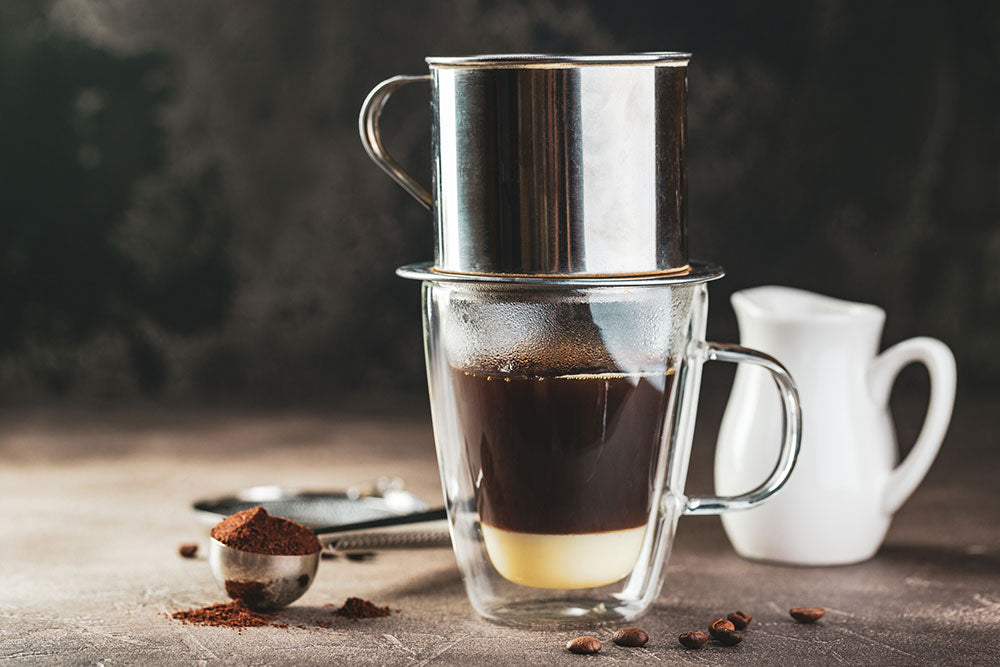Vietnamese Coffee (Cà Phê Sữa Đá)

Vietnamese coffee has gained worldwide recognition for its unique flavor profile and distinct brewing methods. Originating from Vietnam, this coffee style combines the rich history of coffee cultivation with the cultural influences of French colonization. From the traditional brewing techniques to the vibrant coffee culture, Vietnamese coffee offers a delightful experience that sets it apart from other coffee varieties.
Introduction
When it comes to coffee, Vietnam has made a name for itself on the global stage. Vietnamese coffee, known for its robust flavor and smoothness, has captivated coffee enthusiasts worldwide. This article aims to delve into the rich history, brewing techniques, popular drinks, cultural significance, health benefits, sustainability efforts, and global presence of Vietnamese coffee. Let's embark on a journey to discover the essence of this beloved caffeinated beverage.
History of Vietnamese Coffee
The history of Vietnamese coffee dates back to the late 19th century when French colonizers introduced coffee cultivation to Vietnam. Under French rule, coffee plantations flourished, transforming Vietnam into a major coffee-producing country. Today, Vietnam is the second-largest exporter of coffee globally, thanks to its favorable climate and fertile soil.
Types of Vietnamese Coffee

Robusta Coffee
Robusta coffee, primarily grown in Vietnam, accounts for a significant portion of the country's coffee production. The robusta plant thrives in Vietnam's diverse microclimates, resulting in beans with distinct characteristics. Vietnamese robusta coffee is known for its full-bodied flavor, earthy notes, and higher caffeine content compared to other coffee varieties. The robusta beans are prized for their natural resistance to pests and diseases, making them a sustainable choice for Vietnamese coffee farmers.
Arabica Coffee
While robusta dominates the Vietnamese coffee scene, Arabica coffee also plays a significant role. Arabica beans are grown in higher altitudes, resulting in a more delicate flavor profile. Vietnamese Arabica coffee offers a smoother taste, with hints of fruitiness and floral notes. Although Arabica production is not as widespread as robusta, its popularity is steadily growing, catering to coffee enthusiasts seeking a different coffee experience.
Traditional Vietnamese Coffee Preparation
One of the defining aspects of Vietnamese coffee is the unique brewing method. The traditional Vietnamese coffee preparation involves using a small metal filter called a "phin." The phin filter sits on top of a cup, allowing hot water to slowly drip through the coffee grounds, extracting the flavors and aromas.
To prepare Vietnamese coffee, start by adding medium-ground coffee into the phin filter. Gently press the coffee with the filter press and pour a small amount of hot water into the phin to moisten the coffee grounds. Afterward, add the remaining hot water and let it drip through. The process takes a few minutes, allowing you to savor the anticipation of your freshly brewed cup.

Popular Vietnamese Coffee Drinks
Ca Phe Sua Da (Iced Coffee with Milk)
Ca Phe Sua Da, or Vietnamese Iced Coffee with Milk, is a quintessential Vietnamese coffee drink. It combines the boldness of Vietnamese coffee with the creamy sweetness of condensed milk. To make Ca Phe Sua Da, start by adding a generous amount of condensed milk to a glass. Then, place the phin filter on top of the glass, fill it with coffee grounds, and slowly pour hot water over them. Stir well to ensure the coffee and milk are thoroughly mixed. Once ready, add ice cubes and enjoy this refreshing and indulgent beverage.
You can also customize Ca Phe Sua Da to suit your preferences. Adjust the amount of condensed milk for a sweeter or less sweet taste. For a stronger caffeine kick, opt for an extra shot of espresso-like Vietnamese coffee. Ca Phe Sua Da is a popular choice, especially during hot summer days when its cooling effect provides a delightful respite.

Ca Phe Trung (Egg Coffee)
Another unique Vietnamese coffee drink is Ca Phe Trung, also known as Egg Coffee. This specialty drink combines the richness of coffee with the creamy decadence of a whipped egg mixture. To make Ca Phe Trung, start by preparing the egg mixture. Whisk together egg yolks, condensed milk, and a touch of sugar until frothy and creamy.
In a separate cup, brew a strong cup of Vietnamese coffee using the phin filter. Once the coffee is ready, pour it into a glass, leaving some space at the top. Gently spoon the egg mixture on top of the coffee, creating a luscious layer. The contrast between the dark coffee and the creamy egg mixture makes Ca Phe Trung visually appealing.
Ca Phe Trung is a delightful dessert-like coffee drink that offers a unique taste experience. The silky texture of the whipped egg, combined with the robust coffee flavor, creates a harmonious balance of sweetness and bitterness. This indulgent treat has become a beloved part of Vietnamese coffee culture.
Vietnamese Coffee Culture
Coffee plays a significant role in Vietnamese culture and social life. Coffee shops and cafes are bustling hubs where friends, families, and colleagues gather to socialize, relax, and conduct business. Vietnamese coffee culture emphasizes taking the time to savor the coffee, engaging in conversation
Vietnamese coffee shops are often vibrant and lively spaces, decorated with unique aesthetics that reflect the country's rich cultural heritage. Customers can choose from a variety of seating options, from cozy corners to sidewalk tables, providing an opportunity to observe the hustle and bustle of everyday life.
Coffee in Vietnam is more than just a beverage; it's a social experience. People often spend hours at coffee shops, engaging in deep conversations, playing board games, or simply people-watching. It's common to see locals leisurely sipping their coffee while reading a newspaper or catching up on work.
In addition to the social aspect, Vietnamese coffee culture is also steeped in rituals. From the careful preparation of the coffee using the phin filter to the art of slowly savoring each sip, there is a sense of mindfulness and appreciation for the moment. Vietnamese coffee culture encourages individuals to take a break from the fast-paced world and find solace in the simple pleasure of enjoying a cup of coffee.
Health Benefits of Vietnamese Coffee
Beyond its delightful taste, Vietnamese coffee offers potential health benefits. Coffee is known to contain antioxidants and beneficial compounds that contribute to overall well-being. Studies have shown that moderate coffee consumption may reduce the risk of certain diseases, such as type 2 diabetes, Parkinson's disease, and certain types of cancer.
Vietnamese coffee, particularly robusta, contains a higher caffeine content compared to other coffee varieties. This can provide a natural energy boost and improve mental focus. However, it's important to consume coffee in moderation and be mindful of individual caffeine sensitivities.
As with any dietary considerations, it's advisable to consult with a healthcare professional to understand how coffee consumption fits into your personal health and wellness goals.
Sustainable Coffee Production in Vietnam
The Vietnamese coffee industry has recognized the importance of sustainable practices to protect the environment and support the livelihoods of coffee farmers. Efforts are being made to promote organic farming methods, reduce water usage, and implement fair trade practices.
Organic coffee farming avoids the use of synthetic fertilizers and pesticides, promoting soil health and biodiversity. By choosing organic Vietnamese coffee, consumers can support environmentally friendly practices and enjoy coffee that is free from potentially harmful chemicals.
Fair trade practices ensure that coffee farmers receive fair compensation for their hard work and dedication. Fair trade organizations help establish equitable trade relationships, improving the livelihoods of farmers and promoting sustainable community development.
Vietnamese Coffee Brands and Export
Vietnamese coffee has gained global recognition for its unique flavor and quality. Several Vietnamese coffee brands have emerged as leaders in the industry, catering to both domestic and international markets. These brands prioritize the use of high-quality beans and uphold the rich traditions of Vietnamese coffee.
Trung Nguyen Coffee is one of the most prominent Vietnamese coffee brands, known for its extensive range of coffee products and commitment to sustainability. Other notable brands include Vinacafe and Highland Coffee, which have successfully expanded their reach beyond Vietnam's borders.
Vietnamese coffee's popularity has led to its export to various countries worldwide. Coffee enthusiasts from all corners of the globe can now enjoy the distinct taste and experience of Vietnamese coffee in their own homes or local coffee shops. The export market continues to grow, showcasing the global appeal and demand for Vietnamese coffee.
Conclusion
Vietnamese coffee is more than just a delicious beverage; it's a cultural experience that combines history, tradition, and social connection. The unique brewing methods, the indulgent drinks like Ca Phe Sua Da and Ca Phe Trung, and the vibrant coffee culture make Vietnamese coffee stand out in the world of coffee.
Whether you're a coffee connoisseur seeking new flavors or simply curious about exploring different coffee traditions, Vietnamese coffee offers a captivating journey for your taste buds. So take a moment to savor the rich aroma, indulge in the flavors of Vietnamese coffee, and immerse yourself in the warmth of Vietnamese coffee culture.
FAQs
- What makes Vietnamese coffee different from other types of coffee?
Vietnamese coffee stands out for its robust flavor, often attributed to the predominant use of robusta beans. The unique brewing methods, such as the phin filter, and the addition of condensed milk or whipped egg mixture, create a distinctive taste experience.
- Can I make Vietnamese coffee without a phin filter?
While the phin filter is traditionally used to brew Vietnamese coffee, you can try using a French press or a pour-over method as alternatives. However, using a phin filter is recommended to fully capture the essence of Vietnamese coffee.
- Is Vietnamese coffee stronger than regular coffee?
Vietnamese coffee, especially robusta, is known for its higher caffeine content compared to other coffee varieties. However, the strength of the coffee can also depend on factors such as brewing ratio and personal preference.






